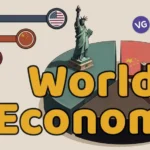The rapid advancement of technologies have become a driving force in today’s global economy. Nations around the world, including China, have recognized the importance of staying at the forefront of critical technologies. To achieve this goal, they are making significant investments in STEM infrastructure and the future workforce. This article explores the strategies and initiatives undertaken by China and other nations to secure their positions as leaders in the technological landscape.
The Importance of Critical Technologies
Critical technologies, such as artificial intelligence, biotechnology, quantum information sciences, cyber, and space systems, have the potential to shape the geoeconomic landscape for decades to come. The nation that leads in these industries will enjoy economic benefits, military advantages, and the ability to influence global norms and rules. Recognizing this, China has made it a strategic priority to achieve primacy in future technologies through a multi-decade plan.
China’s Multi-Decade Strategy
China’s plan involves increasing the size and value-add of its economy, boosting research and development (R&D) intensity, and mobilizing academia, businesses, and the government to drive technology innovations. Beijing employs a range of mercantilist trading policies and industrial strategies to gain an advantage, including import substitution and the transfer of technology. Through initiatives like the Belt and Road Initiative (BRI) and the Digital Silk Road (DSR), China aims to expand its economic sphere of influence and create a technology infrastructure that supports economic development.
The Response from Other Nations
Other nations, including the United States, have taken notice of China’s ambitions and are responding accordingly. Leaders recognize that China’s rise as an economic and technological superpower presents significant risks to their national interests. They understand the need to compete and, in some cases, cooperate with China in areas of shared concern. However, they also acknowledge the importance of maintaining their own economic and technological strengths.
Investing in Critical Technologies
To bolster their capabilities in critical technologies, nations are investing in research and development, talent development, and the creation of an innovation-friendly environment. Increased federal funding for R&D, particularly in STEM fields, is a priority for many countries. The United States, for example, aims to increase federally-funded R&D to at least 2% of GDP. This investment will not only spur innovation but also contribute to the development of a robust STEM talent pipeline.
Developing the Future Workforce
Recognizing the importance of a skilled workforce in driving technological advancements, nations are investing in education and training programs. Science, technology, engineering, and mathematics (STEM) education is a key focus, with efforts aimed at fostering interest and proficiency in these fields from an early age. By investing in STEM education today, nations can ensure a steady supply of skilled workers capable of contributing to research and development activities.
Targeted Policies for Success
To address the challenges posed by China’s economic practices, nations are implementing targeted policies. These policies aim to protect national security, promote fair competition, and safeguard critical supply chains. Export controls on advanced technologies, investment restrictions, and the development of trade remedies are among the measures being taken. By focusing on specific areas of concern, nations can more effectively address Chinese actions without resorting to broad, indiscriminate measures.
Collaborating with Allies
Recognizing the limitations of unilateral actions, nations are increasingly turning to collaboration and cooperation with their allies. By working together, they can amplify their impact and create a united front against unfair trade practices and intellectual property theft. Initiatives like the Indo-Pacific Economic Framework (IPEF) provide a platform for like-minded nations to align their economic policies and counter China’s influence. By pooling their market demand, nations can create alternative supply chains and reduce their reliance on China.
Balancing Economic and Security Concerns
While nations seek to protect their economic interests, they must also navigate the delicate balance between economic cooperation and security concerns. The risk of armed conflict, particularly over sensitive issues like Taiwan, is a significant challenge. Nations must be prepared for such contingencies while actively working to mitigate them. Engaging with China on areas of common interest, such as climate change and nuclear security, can help build trust and reduce the likelihood of military confrontation.
The Need for Strategic Focus
In navigating the complexities of the U.S.-China economic relationship, policymakers must maintain a strategic focus. Rather than seeking to limit China’s economic growth outright, the emphasis should be on countering specific tactics and behaviors that pose risks to national security and fair competition. Targeted policies that address these concerns, combined with collaboration with allies, can help ensure a more prosperous and secure future.
Conclusion
China and other nations are acutely aware of the importance of investing in critical technologies, STEM infrastructure, and the future workforce. The race to lead in emerging technologies has prompted strategic initiatives and investments. By focusing on targeted policies, fostering innovation and talent development, and collaborating with allies, nations can navigate the challenges posed by China’s rise while safeguarding their own economic and security interests. The path forward requires a delicate balance of competition and cooperation, with a clear strategic focus on protecting national interests and promoting a rules-based international order.

















Leave a comment